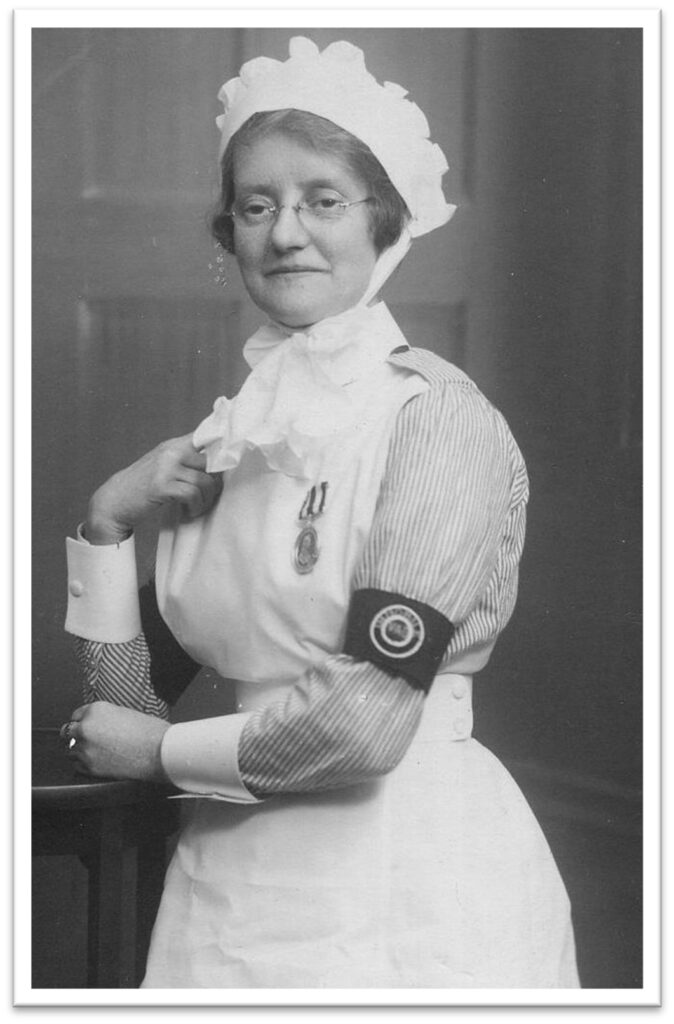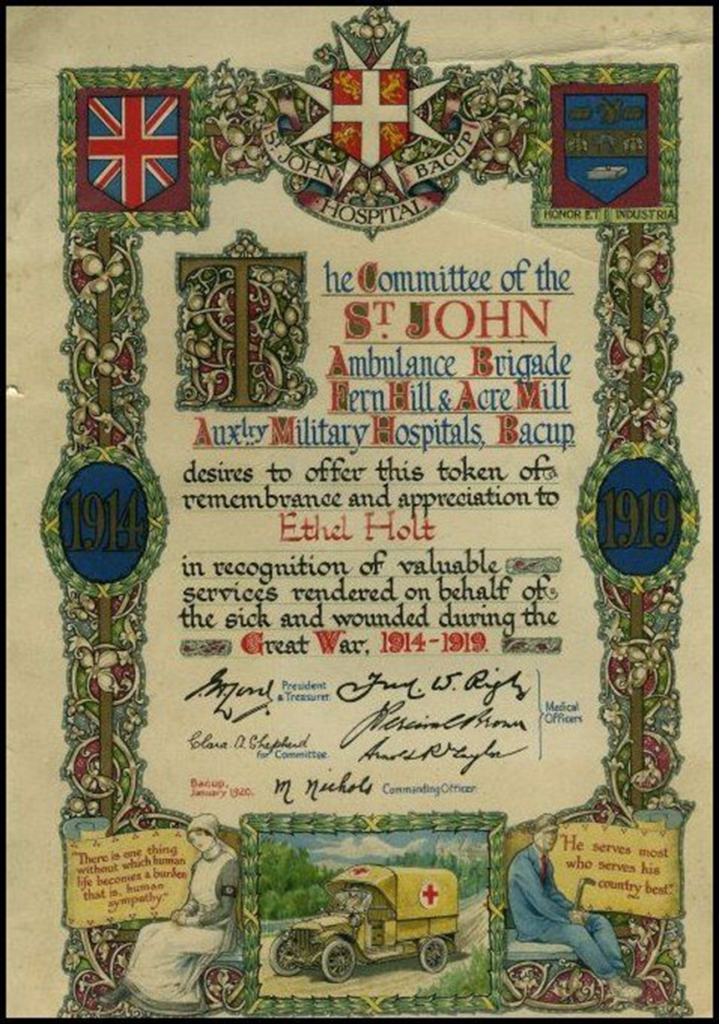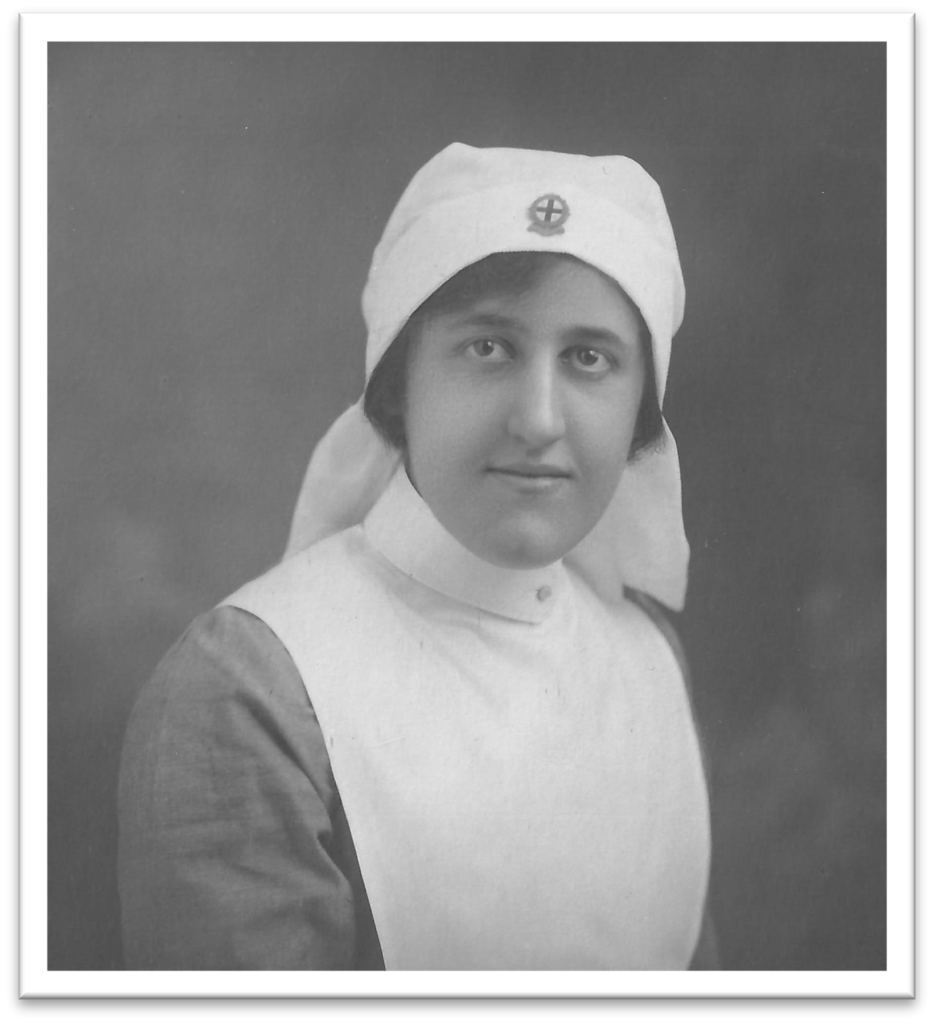Service during wartime was not new for the Bacup Brigade of the St John Ambulance, as many of its members had participated in the Boer War. This conflict highlighted the need for improved medical and nursing services, as it became evident that they would struggle to cope in the event of another war. Starting in August 1909, a scheme was established where members of the British Red Cross and the St John Ambulance Brigade collaborated to organize male and female Voluntary Aid Detachments (VADs). Each VAD was exclusively male or female. The male detachments consisted of 56 volunteers, led by a Commandant, a Medical Officer, a Quartermaster, an Honorary Secretary, a Pharmacist, and four sections. Each section was headed by a Section Leader and included 12 men.
The recruitment of male detachments was more challenging due to the larger numbers needed. In contrast, it was considerably easier to recruit female detachments, which consisted of 24 women, including a Commandant and a Lady Superintendent, who was typically a trained nurse. Similar to the male detachments, the female units were organized into four sections, each led by a Section Leader and consisting of either four women or, in some cases, two sections led by a Section Leader with nine women. Additionally, every female detachment was required to include four proficient cooks.
To become fully proficient members, the female volunteers were expected to undergo training and pass examinations in both first aid and home nursing. They learned to bandage wounds and perform simple dressings while attending weekly classes taught by Drs. Brown, Rigby, and Taylor at the St John Ambulance headquarters on King Street.
In contrast, the male detachments focused solely on first aid training. They were the first to leave Bacup at the outbreak of war, serving as Naval Sick Berth Reservists at various naval bases, which helped to relieve regular naval personnel for other duties.

The female volunteers had to provide their own uniforms and replace them as needed. While there are no records detailing the cost of these uniforms, it is generally accepted that the role of Voluntary Aid Detachments (VADs) was primarily undertaken by girls from wealthier middle-class families. My research indicates that in Bacup, many of the Voluntary Aid Detachment (VAD) nurses at Fern Hill came from working-class families, particularly mill girls who volunteered their time. They balanced their shifts between the mills and hospitals in Rochdale and later in Whitworth, typically working one week out of every four.
VAD members underwent a probationary period before committing to serve for at least three months. The staff at Fern Hill included the Lady Superintendent, Miss Simpson, and the Matron, Mrs. Sutcliffe. There were also eight section leaders overseeing 32 VAD nurses. These section leaders were 1st Lady Officers Miss Rushton, Miss Taylor, Miss S.E. Howorth, Miss Thompson, Miss Blythe, Miss Graham, Miss Settle, and Miss A. Howorth.
In January 1915 when enquiries were made as to how many trained nurses worked at Fern Hill the lady Superintendent wrote: In reply to the official circular about how many trained nurses they had (each hospital was supposed to have a minimum of two), ‘ Our Hospital is only a Convalescent Home, not a Military Hospital, which we offered with 10 beds. Our staff consists of one fully trained nurse who has offered her services
voluntary (sic), myself in charge of the House and my First Officer who is responsible for cooking. 5 of our members come on every Sunday for a week to act as maids and all work is voluntary. We have had 3 batches of Wounded English soldiers from the Western Hospital, Manchester, none of whom have been bed cases.’ and in an accompanying letter to Mrs Beryl Oliver ‘ I trust the information enclosed is satisfactory as two trained nurses here for 10 men who are not in bed would be quite unnecessary, then again it is a convalescent Hospital not a Military Hospital and has been accepted as such.’

The behaviour of Voluntary Aid Detachments (VADs) during wartime was closely regulated by the Joint War Committee of the British Red Cross and the Order of St. John. Each role and rank was distinguished by the colour of their uniforms: Matrons and Lady Superintendents wore prominent bright scarlet or black dresses. Quartermasters donned grey uniforms, while cooks wore pale brown. VADs affiliated with the Order of St. John were dressed in grey dresses, in contrast to the mid-blue attire worn by nurses from the British Red Cross Society.
All nurses were expected to wear the correct clean white headgear, along with starched, detachable collars and cuffs. The handkerchief-style hat, tied at the nape of the neck, was introduced between August and November 1915. The Red Cross emblem, often seen on the apron, was not part of the regulation attire and had to be made and sewn on by the Voluntary Aid Detachments (VAD). A shortage of red cloth soon led to the discontinuation of these red crosses.
During the autumn of 1917, stripes were introduced on the sleeves of uniforms, with different colours denoting various statuses. White stripes were issued to VADs working for the Joint War Committee to signify their length of service, while red stripes were awarded to VADs under contract to the War Office, indicating they had been certified as “efficient” by their Matron and Commanding Officer. Later in the war, Joint War Committee nurses could also be awarded blue efficiency stripes.
At Fern Hill, the duties of the VADs would have been similar to those of other Red Cross Auxiliary hospitals. Soldier patients were under the care of the Medical Officer; in the case of Fern Hill, this was primarily Dr Brown of Burwood House, with Dr Taylor providing dental care and Dr Rigby occasionally reported to be at the front.
The Medical Officer made daily visits, depending on the patients in residence and their wounds or illnesses. Patients who were able would be helped to get up and prepare for the Medical Officer’s rounds, which included assistance with shaving, washing, and dressing. Patients on bed rest were also helped to be made presentable.
Throughout the day, the nurses attended to patients’ medical needs, which included changing dressings, managing bedpans and sputum cups, assisting with inhalers for those with lung issues, and helping to feed patients who were unable to feed themselves. They also performed various tasks to maintain the hospital’s cleanliness and comfort. In addition to these responsibilities, the nurses helped patients write letters to loved ones, read to those who were visually impaired, and occasionally accompanied them on outings. Whilst the vast majority of the staff was female, there were some male volunteers such as Hospital Secretaries Mr Henry Shepherd and Fred Cooper and male orderly Wilson Greenwood. Again, there are very few official records available locally, although there are some held by the Red Cross.

On the evening of January 16, 1920, a ceremony was held at the Bacup Liberal Club to mark the end of an era for the Fern Hill and Acre Mill Auxiliary Military Hospitals. During this event, the hospital committee presented certificates and medallions to all staff members who had served for one year or more.
The medallions, donated by a mysterious benefactor, were specifically awarded to those staff members who had served the full four years of the hospital’s operation. Mr. J. H. Lord, J.P., the chairman of the Fern Hill Hospital Committee, presided over the event. He spoke of a time when the people of Bacup and Stacksteads witnessed ambulances transporting sick, wounded, and maimed soldiers through the town, where they were cared for by the dedicated staff of the two hospitals.
In total, 64 illuminated certificates of thanks were awarded. These certificates featured the mottos, “He serves most who serves his country best” and “There is one thing without which human life becomes a burden: that is human sympathy.”
In all 25 members received medallions and certificates for four years’ service they were: Mary Nichols, Kate Sutcliffe, Elizabeth Rushton, Emily Thompson, Sarah Elizabeth Howorth, Laura Blythe, Annie Howorth, Lily Howorth, Clara Hoyle, Ethel Foster, Betsy Colbert, Nellie Ashworth, Amy Taylor, Martha Jane Whittaker, Bertha Ayres, Mary Shepherd, Alice Shepherd, Annie Pickup, Fred W Rigby, J Percival Brown, Arnold Taylor, Henry Shepherd, Fred Cooper, J H Lord, W.G.Lambert.
Recipients of certificates only were: Mary Lord, Hannah Graham, Bertha Tattersall, Ada Townsend, Annie Howarth, Emma Jackson, Sarah E Fielden, Dorothy Beeby, Maria Baldwin, Betsy Hanson, Nellie Pilling, Ruth Hitchen, Annie Edwards, Elizabeth Hacking, Sarah Ellen Pickup, Fanny Hoyle, Alice Hirst, Doris Shepherd, Edith Barnes, Alice Earnshaw, Margaret Annie Law, Agnes Jane Ormerod,
Emma Flack, Hannah Hargreaves, Mary Alice Stevenson, Gertie Hallam, Rose Hardacre, Hilda Abbott, Mary Hannah Turner, Annie Bentley, Alice Hoyle, Florence Hardman, Maria Netherwood, Ethel Holt, Norah Riley, Jeanie Simpson, Susannah Crawshaw, Mary Horrocks, Hannah Jane Johnson.
